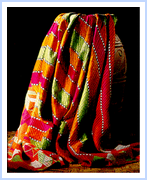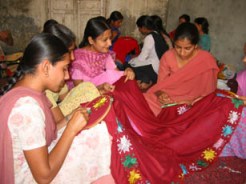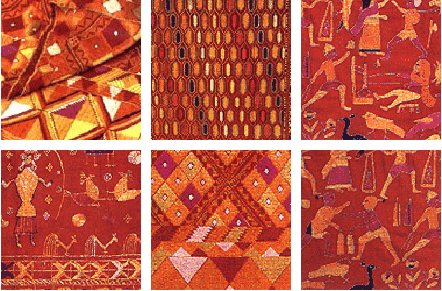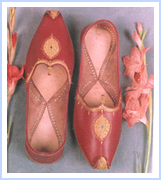Punjab - Culture - Art and Crafts
Art is described as a creation or expression of something beautiful especially in a visual form and arts and Crafts as a phrase means decorative designs and handicrafts. In this field, also, Punjab has a distinguished tradition, which its people have maintained in spite of the passage of time.
Mudwall Painting
Plastering the walls with mud and drawing ferns, plants, several other fascinating motifs has been a way of life of the woman of Punjab. They have also been making paper mache utencils made by mixing paper and various kinds of earth, for storing house hold necessities in colourful designs.
The mudwalls of the rural houses in Punjab are painted on festive occasions like Dushera, Karva chauth( the day on which fast is observed by the women for the well being of their husbands), Holi, Diwali etc.. One is spellbound by the attractive and intricaterly composed patterns and designs painted on the mudwalls which are intended to invoke the blessings and welcome Lakshmi, the goddess of wealth and plenty. These drawing are mostly done by the women. The art of mudwall paintings in Punjab is called Chowk-Poorana.
Basketry
The weaving of the vegitable fibres and the making of wicker articles for daily use are amoung the oldest creations of human hands. The evolution of products made of vegitable fibres is still preserved in the living tradition of rural products made of osier bast, straw commonly known in Punjab as Sarkanda, interwoven with bast, reeds, rushes and corn husks.The craft of basketry is widely practised all over Punjab. After shaving, thin straws of this grass, are woven into beautiful carpets, curtains etc.. Amoung these products the handfan is very popular and fascinating on account of its curled shape. These fans are popularly known as Peshawari Pakkhe. The ones smaller in size are very fine and delicate. These are called Kundaladar Pakkhi on account of their curled ends.

Another useful household contrivance called Chhaj in Punjabi was manufactured out of sarcanda which is used for separating edible stuff from the grain. Screens, used as a parting between wheat and hay, for instance, were also woven from this stuff. Baskets used for keeping pins, cotton, buttons, needles, threads etc., in different shapes and colours were contrived by young girls by using shaved sarcanda and coloured cotton thread which were taken by them as a part of dowry. In Punjabi these are called katnees.
The shavings of sarcanda chicks and coloured cotton threads were also used to weave Chiks, Bohey, Pitarian, (useful household article) and kind of chairs called Moorras.
Durries (cotton bed or floor spreads)
Weaving of durries in myriad motives and designs especially by young girls in the villages has been a long tradition in Punjab. These are also woven in stirpes, check boards, squares, motifs of birds, animals and even plants as a part of dowry.

Needle work and Phulkari
Needle work of Punjab is unique, it has beautiful names because of its associations with beautify aspects of life and the beautiful designs which the fingers of Punjab’s proverbially beautiful women create have such a wealth of forms and motifs that they defy enumeration. Some of these are called Baghs, literally a garden, Phulkaris, literally flower work, rummals, scrafs etc.. The pattern of needle work done on the bed spreads, chunnis, dupattas (these are head covers) and shirts and Salvars, are still different.

Needle work on phulkaris is done on a deep coloured cotton cloth with striking silk threads. The threads is pierced upwards from underneath the cloth into free-hand motifs, while in the Baghs and Rummals such cloth is worked on the top side only. These were traditionally used for wearing but now are exported as wall hanging and sewn as jackets etc.
Phulkari, meaning flower work, is a spectacular style of embroidery peculiar to Punjab, and an essential part of everyday life. Almost every cermony in which women participate is given a touch of additionl colour and richness by the use of phulkari on account of its being considered auspicious.

This embrodery lends itself to making large surfaces.The process is slow and laborious. The art is acquired with a great deal of effort. It has infinite patterns testifying to the creative ability of the needle-women, made up of vertical, horizontal designs. The total effect is that of florance magnificance. It is essentially a faminine craft and very domestic in all its eessential features. It is an art because of harmonious colours.
This type of embroidery is so excellently done that it is hard to distinguish between the left and right or upward and downward side. It has the look of a carpet .The patterns are not restricted or controlled, but bold, free and highly imaginative. The designs and motifs are an expression of the embroiderer’s thought and aspirations. These women can stitch a railway train, motorcar, lorry or even a rath (chariot) out of sheer curiosity. Birds, domestic and wild animals in different sizes and from different angels are common.
This handicraft did not arise out of any pure artistic motive, but mainly to satisfy domestic necessity. The inborn talent and spontaneous approch of the uneducated village women, her deft hand and resourcefulness have raised such works out of the realm of necessity into the domain of art, pleasing in colour and designs as they are. Another peculiarity of this embroidery is that no two Phulkari’s are alike.
Leather craft
Punjabi Juttis are embroidered with gold and silver wires all over in different patterns covering every parts of the pair so that it looked as if it was made of solid gold and silver. Now even when golden and silver threads are used to embroider these shoes, the quality of these world famous shoes is still maintained.

Wood carving
It is the most ancient and popular craft worked withal by an ordinary carpenter and the most expert of artists. The woodwork of Punjab has been traditionally famous. Artistic beds with comfortable, skillfully made back rests fitted with mirrors, low seats called Peeras, Peerian were made by carpenters in almost every village. Furniture designed in Punjab and boxes, toys and decorative pieces made out of lacqueur finish to wood crafts, in adorning it with engraving wood, inlaying ivory (now white plastic only) the workmen of Punjab have been renowned. Woodcarving in Punjab is practised in Batala, Amritsar and Hoshiarpur.

Metal work
Metalwork in Punjab is also very famous. The common use of metal objects in daily life necessitated the evolving of various products and techniques. The metal workers of Amritsar are known for their skill in various forms of casting, soldering, methods of decoration such as repousse, pierced work, chasing, engraving etc.

Metal pots and utensils, objects like lamps and trumpet necessary for religious rituals and some decorative items like lamp shades etc are some of the items on which these artisians work on. Amongst all these items the most remarkable are the engraved metal doors and the figurative engraved panels of the Temples and Gurudwara’s. At times these metal doors are plated with gold and silver and a very fine repousse work done on them.